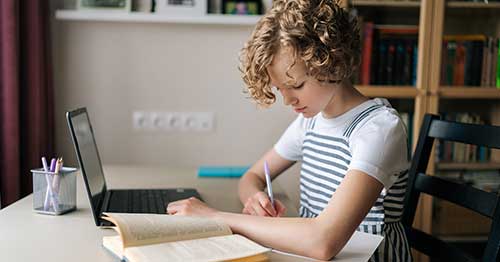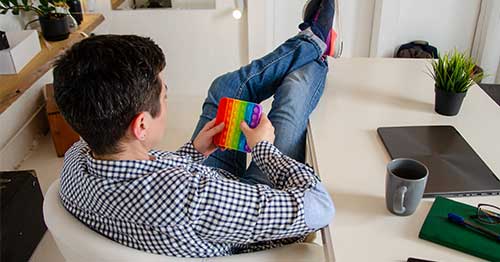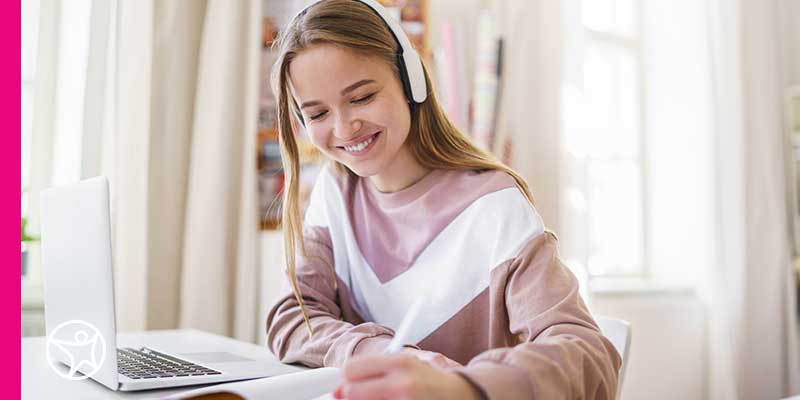4 Ways Parents Can Make Homeschooling Stress-Free
by Alyssa Austin
byAllison Brubaker
5 min to readIt’s easy to get caught up in multitasking or trying to perform more than one task at a time. Whether it’s texting a friend while eating dinner or having a conversation in the car while driving, multitasking is something most of us do every day!
While some multitasking is harmless, it becomes a problem when one task interferes with the other. When it comes to multitasking and learning, research shows that multitasking can have negative effects. Therefore, many families are seeking tips on multitasking and ways for their student to avoid multitasking while studying and attending classes or doing extracurricular activities.
Virtual students are especially prone to multitasking because they’re surrounded by digital distractions. When students try to multitask while studying, they often fail without realizing it. Examples of multitasking in school might look like checking their phone while attending a class or watching videos or TV while doing homework.
Psychology professor David Meyer says, “Under most conditions, the brain simply cannot do two complex tasks at the same time. It can happen only when the two tasks are both very simple and when they don’t compete with each other for the same mental resources. . . . But listening to a lecture while texting, or doing homework and being on Facebook—each of these tasks is very demanding, and each of them uses the same area of the brain, the prefrontal cortex.”
When these types of tasks compete for mental resources, one wins a student’s attention and the other loses. Students may think they’re multitasking, but they’re actually just task switching.
Scientific research has shown that when young adults switched between different tasks, they lost time while performing the tasks, especially when the new task was unfamiliar to them. Other studies show that task switching also creates more opportunities for error. Therefore, parents and Learning Coaches should use caution when allowing students to multitask while studying.
While multitasking has negative effects, there are also ways that students can multitask effectively.
Research shows that multitasking has several negative effects on learning.
Multitasking can:
For these reasons, your student may want to learn how to stop multitasking, or how to multitask in a more productive way. If your student is used to multitasking throughout the day, the best thing they can do is break the habit and find other ways to get things done.

Here are nine ways to help manage multitasking for your online student:
The first thing you and your child should discuss is when multitasking is OK and when it isn’t. For example, you might have your child avoid multitasking during lessons, dinner, conversations, and group activities so your child can practice giving one task their full attention. On the other hand, perhaps you allow multitasking after school. For example, your student can watch TV while texting friends after lessons and homework are complete.
Your child can develop scheduling skills by deciding how to prioritize their own tasks. You can also revisit your child’s weekly schedule or routine to make sure their time is being used effectively.
Instead of jumping between tasks, your child can schedule blocks of time for lessons with regular breaks in between. For example, your student might spend 45 minutes on math homework and then take a 15-minute break. Short breaks allow your child’s brain to rest and give them a chance to multitask on something not school related.
Making phones, video games, or other devices off limits during lessons goes a long way. This way, your child won’t be distracted by incoming texts or social media notifications. If your child is likely to stray from lessons while on the computer, use an internet restriction app or parental control app to prevent them from visiting certain websites during school hours.
Besides removing digital devices, help your child clear all other distractions from their workspace. Cleaning up messes, removing unnecessary objects, and keeping everything in the right place can help your student stay focused on their work rather than being distracted by a messy work area.
It’s not always easy to stay focused on a single task, so teach your child different tricks for maintaining concentration. For example, one way to improve focus and learning retention is to take notes while reading or listening to a lesson. Another technique is workshifting, or finding another place to work where there are fewer distractions.
Sometimes, students are so busy that they feel the need to do a lot of things at once. But what students really need to do when they’re feeling stressed is relax. By relaxing, students can regain the focus they need to do one task at a time; plus, they’ll perform better and faster.
For kids who need extra help with focusing, you can use focus music or a fidget toy, which may help them multitask in a productive way. Playing focus music such as classical music in the background or allowing your student to play quietly with a fidget toy can help some kids improve focus.

Watching YouTube videos while doing homework is likely to be unproductive, but there are some tasks that can be done while doing schoolwork. For example, your student could do light chores around the house or go for a walk while listening to a recorded lesson or an audiobook.
While it can be difficult to figure out how to stop multitasking altogether, small steps can go a long way. Some students multitask more than others, so they will have to work harder to adopt better study habits. But with the above tips on multitasking and how to avoid it, your student can sustainably work toward creating better focus.
by Alyssa Austin
by Susan Cokas
by Connections Academy
